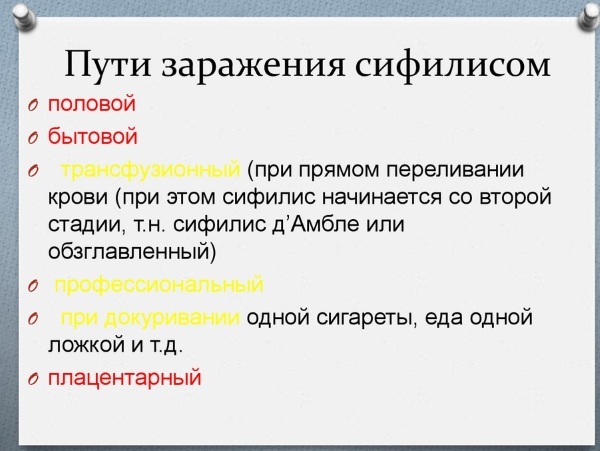Content
- What is audiometry, basic concepts
- Indications for conducting
- Types of research, how is the diagnosis
- Tonal audiometry
- Speech audiometry
- In situ audiometry
- Research methods
- Air conduction
- Bone conduction
- How is the study going
- What does the audiogram form look like, what information does it contain?
- Decoding audiogram, norms
- Research cost
- Audiogram video
The auditory assessment graph is called an audiogram. Sometimes the survey result is presented in the form of a table. Deciphering the data obtained allows you to determine the range of acoustic perception and establish the degree of impairment of auditory function. Indicators in the range of 0-25 dB are considered the norm.
What is audiometry, basic concepts
Perceived by the auditory organ sound waves have 2 main physical parameters - intensity and frequency. During the audiometric examination, the value of both physiological characteristics is determined.
This diagnosis is a medical and technical procedure aimed at analyzing the patient's acoustic function. In otolaryngological practice, the most common is the simplest speech test, which makes it possible to determine the minimum threshold of auditory sensitivity without special technical means.
Audiogram (decoding in the table of the norm or deviations from the established reference values is used when the choice of the method of correction of the acoustic function) is a graphically formatted result survey.
Sound intensity refers to the pressure force of sound waves perceived by the ear. This indicator is individual and variable for each patient. To bring the basic characteristics to a single denominator, relative values are used.
These are decibels in a decimal logarithmic scale. Another key concept in audiometry is tone frequency. To assess this acoustic characteristic of the hearing aid, the number of vibrations of a sound wave propagating in space is measured.
The result is entered into a table or displayed on a diagnostic graph in units of Hz / s. There is a conditional distribution of the frequency of the tone at the high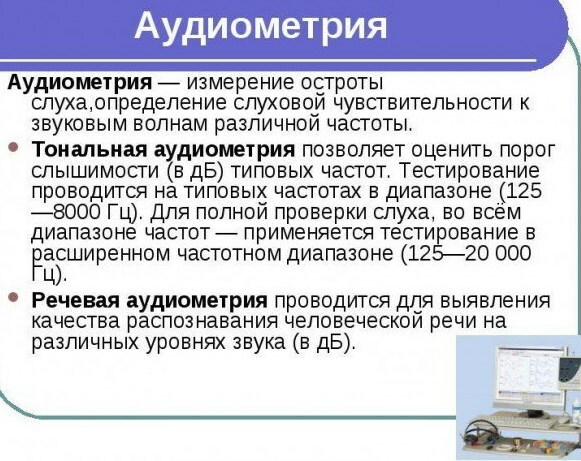 forge, medium and low. The value of the first indicator is in the range over 4000 Hz.
forge, medium and low. The value of the first indicator is in the range over 4000 Hz.
The middle frequency of the tone, called speech, corresponds to an indicator of 500-4000 Hz, the low one is less than 500 Hz. An audiometric procedure aimed at measuring hearing acuity produces subjective results that may vary depending on the physiological state of the subject, the quality of the equipment, and other factors.
The technique requires stable feedback from the diagnosed patient. The survey illustrates the sensitivity of sound vibrations generated by a special device for each auricle separately.
Indications for conducting
The audiometric procedure is performed for prophylactic or clinical diagnostic purposes. In the first case, it is included in the complex of an annual planned examination with a predisposition to otolaryngological diseases.
The procedure allows you to diagnose the development of impaired auditory perception at an early stage, to identify neoplasms, progressive tumor or inflammatory processes.
Clinical indications for audiometry:
- various forms of otitis media;
- inflammation of the middle ear tube;
- postponed traumatic brain injury;
- penetrating wound of the auricle;
- a tangible deterioration in the perception of speech and sounds;
- acute or chronic ENT pathologies;
- neurological diseases;
- stroke;
- diagnosed neoplasms and tumors of cerebral localization;
- congenital hearing impairment;
- otosclerotic dysfunction;
- neuroma of the acoustic nerve;
- infectious lesions of the ENT organs.
Every 6 months it is recommended to undergo audiometry for patients whose professional or work activity is associated with a constant stay in conditions of increased noise - more than 100 dB.
It is necessary to regularly undergo such an examination for elderly people - over 65 years old. Audiometry is prescribed when selecting the model and technical characteristics of the hearing aid.
A prophylactic examination to determine the acuity of acoustic perception is shown after an intensive and long-term treatment with antibacterial drugs - Neomycin, Gentamicin, others. The reason for audiometry is the intake of increased doses of salicylates.
Audiogram (interpretation in the norm table with subsequent interpretation of the results - exclusive competence otolaryngologist-audiologist) is required to assess the effectiveness of therapy for diseases that affect the quality of the auditory functions.
Types of research, how is the diagnosis
The procedure is often performed using a dedicated audiometric monitor. The patient is wearing headphones, through which sound signals are received with a carefully selected intensity and tone frequency.
The simplest technique involves diagnostics using speech contact. This procedure is distinguished by increased subjectivity of the results and lower accuracy than when using an audiograph or medical impedance meter.
Types of acoustic diagnostics:
- Objective. The method is focused on fixing unconditioned reflexes in response to a sound stimulus.
- Speech. It is intended to determine the level of perception of live or spoken speech recorded on a digital carrier.
- Threshold-tonal. Used to assess the patient's audibility of tones.
- Children's. Relevant for testing hearing in newborns and children aged 1-3 years.
- Computer. The research is carried out using specialized software.
The diagnostic centers use specialized equipment manufactured by Otometrics, Intracoustics, and other companies. Such audiographs and impedance meters provide high accuracy of the results of the study of the acoustic function.
The latter measure the shear level of sound conduction in the middle ear region under conditions of variable air pressure. Impedance meters are used in high-precision differential diagnostics of acoustic perception disorders.
Tonal audiometry
The technique determines the lower threshold and the maximum level of perception by the biological hearing aid of sound waves of various frequencies. The full range of research is 125-8000 Hz. The diagnostic measure is carried out in a special soundproofed cabin.
The patient is wearing headphones connected to a device that generates acoustic signals. The subject in response to the received sound presses a key. The quality of the auditory perception of each ear is checked in turn.
Signals with a frequency of 125, 250, 500 Hz and more are sequentially fed until the required threshold is reached. The standard tuning step of the audiometer is 62.5 Hz. The method is designed to determine the minimum and limit values of audibility.
The upper limit fixes the occurrence of discomfort at a given frequency. To determine this condition, pure tones are used in combination with a narrow directional noise pressure.
The device used for this type of audiometric examination is a pair of air telephones with on-ear or plug-in headphones. The package includes a bone vibration generator designed to determine the passage of acoustic waves through solid anatomical structures.
Speech audiometry
The simplest technique aimed at drawing up a graph or forming a table with the results of diagnostics. The speech test involves the determination of the patient's intelligibility of speaking in the native language.
The audiogram obtained in this way is extremely subjective. For the subsequent correct interpretation of the results on the graph or in the table, high clarity of pronunciation and the patient's stay in a state of maximum concentration are required. The norm or hearing impairment is determined by whispering and high-pitched speech.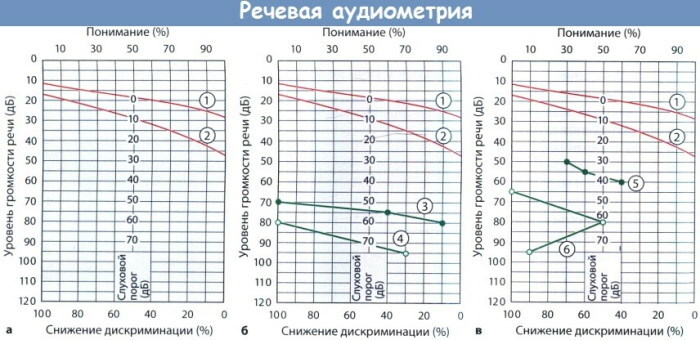
The patient is located at a distance of 25-30 cm from the sound source. High definition digital recording is often used for speech audiometry. The quality and accuracy of the study is ensured by the use of an electronic attenuator - a special device that reduces the amplitude or power of the sound signal without distortion.
The result is influenced by the stability of the frequency parameter of the spoken speech, the variety and complexity of the text. There are special tables of words in Russian for conducting a speech examination.
In situ audiometry
This diagnostic method is used not only to determine the qualitative characteristics of the acoustic function. In situ audiometry is intended for fitting hearing prostheses.
It allows you to establish the optimal technical parameters of the sound-conducting equipment, taking into account the peculiarities of the biological mechanism of acoustic perception. The technique is implemented on modern electronic digital platforms and computing power of wearable gadgets.
The technology enables the patient to perform tonal audiometry independently. Modern hearing aids are equipped with this function.
The procedure adjusts the sensitivity of the device to acoustic vibrations of different ranges. The technology provides an assessment of audibility directly in the hearing aid for accurate calibration of the electronic part of the device.
Research methods
Distinguish between bone susceptibility and air conduction of sound. Each physiological characteristic is investigated by different methods. Accurate determination of hearing thresholds is difficult even with the use of special equipment.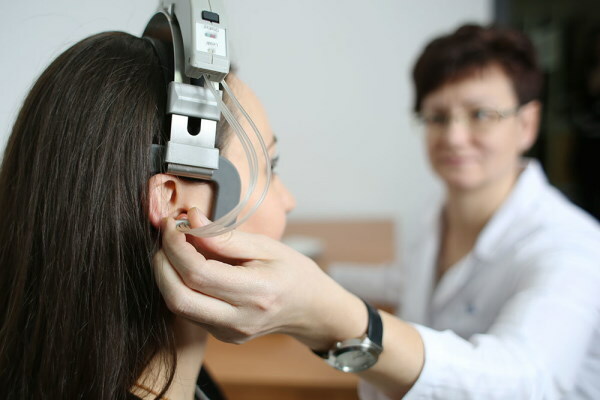
The results of each diagnostic test vary, sometimes quite dramatically. To obtain extremely objective data, several measurements are carried out. The accuracy of the results depends on the qualifications of the doctor, the current psycho-emotional and physical condition of the subject.
Research methods, applied hardware and technologies are constantly being improved, which provides indicators that are close to reality. The gap on the audiograph graph between the lines is called the air-bone gap. Indicators are measured separately for each ear.
Air conduction
This physiological characteristic is considered directly the ability of the auditory organ to perceive acoustic vibrations. A spiral element located in the middle segment of the ear canal is responsible for air conduction.
Hair-type receptor cells cover the sound-perceiving anatomical structure. They vibrate due to the pressure of the air column. There is a transformation of mechanical movements into nerve impulses.
Such signals are transmitted to the body of the auditory nerve and enter the temporal lobe of the cerebral organ, the neurons of which become excited. The physiological mechanism is fixed with special equipment or the patient's feedback.
Audiogram (interpretation in the table of normal indicators or deviations from the established reference values performed after several successive tests) determines the air conductivity with the relative accuracy.
The human ear perceives acoustic waves in a wide range of sound vibrations - 16,000-20,000 units / s. For children, a special technique was developed that allows you to explore the acuity of auditory perception in a playful way.
Bone conduction
This physiological characteristic is due to the ability of hard tissues to pick up acoustic vibrations. Sound vibrations are transmitted to the receptors in the inner part of the auditory tube.
If there are mechanical obstacles in the ear canal in the form of a sulfur plug or tumor formation, acoustic waves reach the nerve fibers due to bone conduction.
This perception of sound is less pronounced than that of air. The study is performed using a special bone vibrator connected to the audiograph and attached to the mastoid process of the auricle.
How is the study going
The procedure is absolutely painless and causes slight discomfort only when high-intensity sound signals are given. Previously, the otolaryngologist examines the ear canal for the presence of pathological changes and mechanical obstacles.
Before a diagnostic session, it is forbidden to take medicines, drink alcoholic beverages. When conducting a speech test to determine the acuity of auditory perception, the auricle not involved in the examination is closed with a finger or clogged with a cotton swab.
When performing the procedure with the use of audiometric equipment, the patient is given headphones through which acoustic signals of various tone frequencies and intensities are received. The examination takes no more than 20-30 minutes. Special preparation for the diagnostic procedure is not required.
What does the audiogram form look like, what information does it contain?
In the examination results, the left and right ear are displayed in a separate graph or table. They are color-coded or signed. Symbols are sometimes used. On the form, the left ear is marked with a cross, the right ear with a circle or square.
The audiogram (decoding in the table of normal indicators or hearing impairments depends on the examination technique) contains the value of bone and air conduction. The first on the letterhead is marked with a dotted line, the second - with a solid line.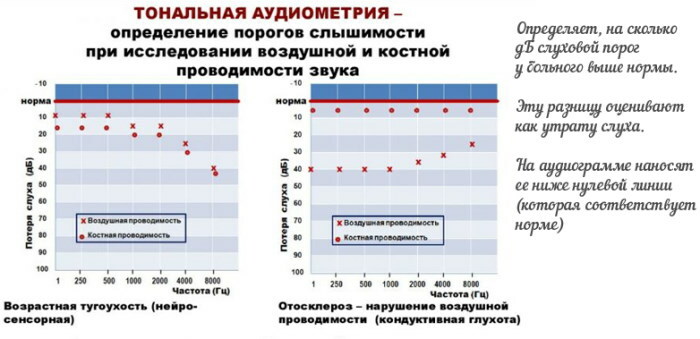
If the audiogram is presented as a graph, the vertical indicates the level of auditory perception in dB, the horizontal indicates the frequency values of the applied acoustic waves in Hz. The standard step is considered to be 5 or 10 dB.
The graph starts at -5 or -10 dB and ends at 100, 110 or 120 dB. The frequencies of the supplied acoustic waves indicate the glory to the right. The starting point is 125 Hz. It gradually rises to a limit threshold of 8000 Hz.
The graph is formed by connecting points at the intersection of frequency with the level of auditory perception. Special fields of the form are filled in with the patient's personal data - full name, age, otolaryngological disorders detected.
Decoding audiogram, norms
With a normal hearing level, the graph is formed by 2 almost straight lines that do not have a pronounced air-bone interval. The points of intersection of the vertical with the horizontal do not exceed 20 dB.
Such a graph indicates the normal perception of sound at each frequency generated by the equipment or spoken acoustic signals. The maximum allowable gap between the bone and air conduction lines is 10 dB.
In case of deviations from the established values, pathological hearing impairments are ascertained with the definition of topics and the degree of damage. They are presented in the table below.
| The degree of dysfunction | Range of acoustic perception at standard frequencies, dB | Distance to the source of spoken language | Distance to the source of the whisper |
| Norm | 0-25 | Over 10 m | 6 m |
| I | 26-40 | 3-6 m | More than 2 m |
| II | 41-55 | Less than 3 m | 10-15 cm from the auricle |
| III | 56-70 | 1-1.5 m | Not perceived |
| IV | 71-90 | Near the auricle | Does not differ |
If the lower threshold of sound perception is more than 90 dB, deafness is diagnosed and the use of a hearing aid is prescribed. A pathological disorder caused by the inability to pass a sound wave through the air is called conductive or conductive.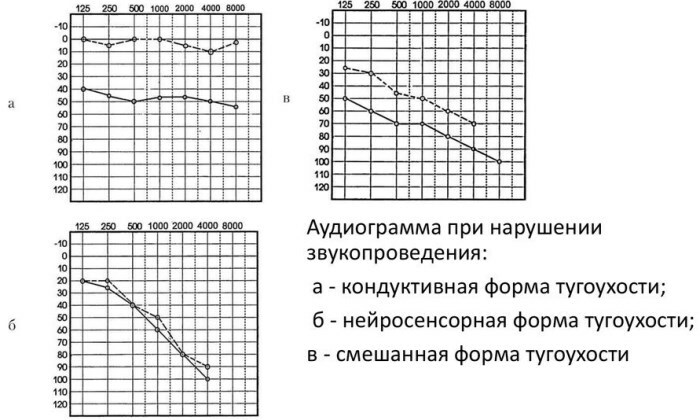
If the otolaryngological abnormality is caused by functional disorders in the area of the inner segment of the ear tube, an audiometric examination reveals a neurosensory lesion.
In rare cases, both hearing loss options are combined. This pathology is called combined. To detect functional disorders of the sound-conducting pathways in the cerebral cortex, one audiometric test is not enough.
Additional neurophysiological studies are required. Hearing loss of this etiology is called retrocochlear. With conductive pathology, the graphs have a characteristic ascending appearance, with sensorineural pathology - a descending one.
Deciphering the result of audiometry is facilitated by the size of the bone-air interval. It allows you to determine the degree of functional impairment and the type of hearing loss.
Research cost
Acoustic diagnostics are offered by many government hospitals. The procedure is free of charge upon medical prescription and subject to a compulsory health insurance policy. In commercial diagnostic centers, the cost of the examination varies between 1200-1500 rubles.
This amount includes the test, the presentation of the result in the form of a graph or table. Additional consultation with an otolaryngologist for transcribing the audiogram is paid separately. If the indicators deviate from the norm, the involvement of a neurologist may be required, which increases the cost of the examination.
Audiogram video
How to decipher an audiogram:


